News

Do You Have Dock Etiquette?
Have you ever been walking down the dock to your pontoon, and there right in the middle of the main walkway is a pile of stuff from someone else’s boat? You look around and don’t see them anywhere, just their stuff. In addition, you can’t get your own dock cart of boating supplies (along with the dog, ukuleles and the cooler) past the “dock block” without moving something. Here’s a question: should you move someone else’s stuff?
Guess this might bring up a bigger topic…dock etiquette.
Let me clarify: I am not the greatest at etiquette. Just in the last few years, I learned about holding your hands up in front of the table setting, the left hand looks like a small “b” for bread, and the right hand looks like a small “d” for drinks. This newfound knowledge has saved me a number of times from messing with someone else’s drink. However, in the grand scheme of etiquette, I needed to look up the definition.
Which is, “A code of behavior that delineates expectations for social behavior according to contemporary conventional norms within a society, social class, or group.”
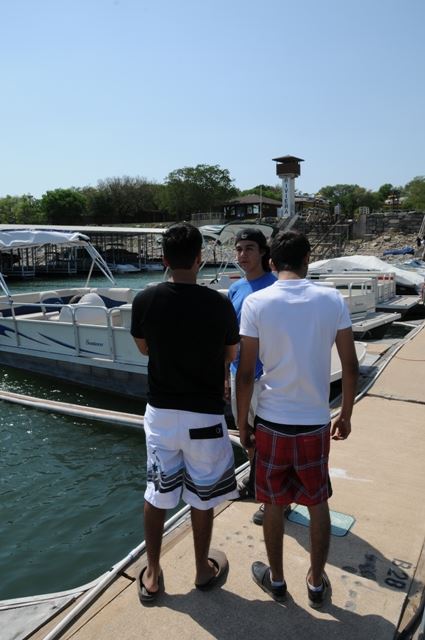 If I have this right, the group is “boaters on my dock” and the social behavior I am looking for is “What’s the correct behavior on my dock?”
If I have this right, the group is “boaters on my dock” and the social behavior I am looking for is “What’s the correct behavior on my dock?”
There are a couple of twists to this. If someone, like a property owner, owns the dock on a lake, it is not my dock and the owner can set the rules. That’s pretty straightforward.
But what about those of us who rent a slip on a dock at a marina? My dock has pontoons, wakeboard boats, sailboats and more. Each has a different set of operating ideas and etiquette. There are basic dock rules as stated by the marina, but there are lots of people who do things way different than me. I am not saying their way is wrong, but it’s not what I would do and I wish they wouldn’t do it that way. But, that’s just me, so is there a correct way?
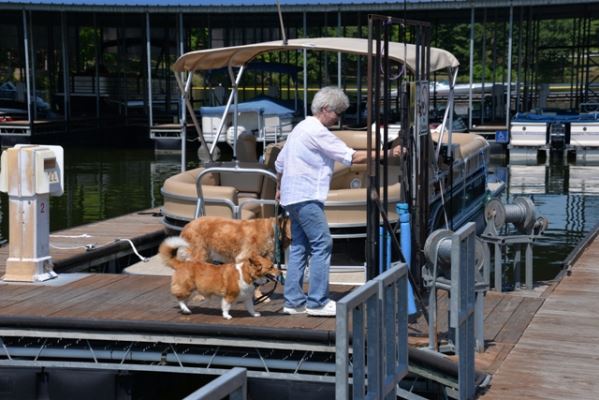 But, a couple boats down, the owners decided they don’t even care where the extra line goes, so it ends up on the dock often where your dock cart wheels have to run over it. I don’t know about you, but I have been found coiling other people’s lines, for safety reasons, to keep them out of the way.
But, a couple boats down, the owners decided they don’t even care where the extra line goes, so it ends up on the dock often where your dock cart wheels have to run over it. I don’t know about you, but I have been found coiling other people’s lines, for safety reasons, to keep them out of the way.
And there is this new trend on the docks that is some kind of a “daisy chain” looping process, which does shorten the extra line, but the stiffer straight-line of excess rope is even harder to get your dock cart over. I do use the same looping process for extension cords at home. It makes it a lot easier to pull one end and it doesn’t get tangled, but it still gets in the way on the docks.
Then there are the loading/unloading piles. You have probably all seen this before. Walking to your boat, there in the middle of the dock is a pile of coolers, clothes and kids. The boat owners are on the boat, cleaning, covering and doing whatever else they need to do before the get on or off. But in the meantime the dock is full blown LA traffic-jammed. I’m not saying I don’t do the same kind of thing sometimes, but I do try and leave a passing lane.
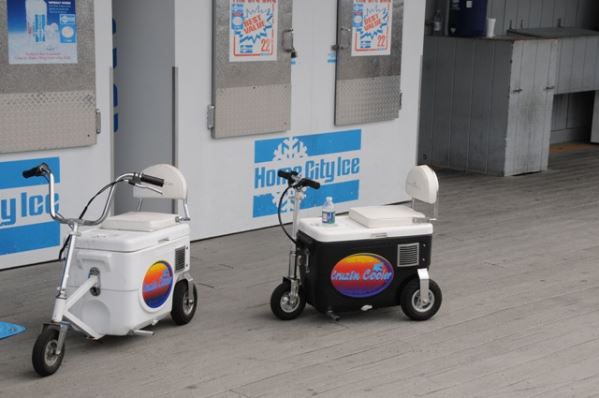 One other thing that kind of gets me: I’m out on the water and when I get back to my slip the boater next to me has loaded up the docks with chairs and coolers, making it difficult for us to step off our boat safely.
One other thing that kind of gets me: I’m out on the water and when I get back to my slip the boater next to me has loaded up the docks with chairs and coolers, making it difficult for us to step off our boat safely.
Guess this makes me sound like I am one of those old “crotchety” guys trying to keep the kids off my dock, but believe me I’m not. I just wish everyone who used the docks thought about other people using the dock and left room, or picked up after themselves etc.
*This article is courtesy Pontoon and Deck Boat Magazine. It is written by Scott "Sky" Smith. For this and more, visit pdbmagazine.com
- Mindy Goodman
- Tags: bad boating habits Boating boating etiquette docking

Fall Marine Drive Checklist
Fall Marine Drive Checklist
Published: Wednesday, September 14, 2022 12:00 pm
By: The Professionals of Henry H. Smith Co.
A version of this article appeared in the Fall (September/October) 2022 of Great Lakes Scuttlebutt magazine.

With the arrival of fall, our thoughts turn to football and apple cider, but before we forget about our boats, let's make certain we check it out very well and ensure we are ready to go at the first signs of warm weather in the spring. Winterizing checklists make certain that all the items that can be damaged by the freezing temperatures to come are cared for, but what about the maintenance items? Fall is a great time to identify them and make plans to look after them well ahead of the spring rush.
The checklist can be broken down into the key components of your drive and will vary depending on the specifics of your boat. Outboards and I/O’s are limited to the propeller and lower unit, while an inboard has a shaft, strut, rudder, and propeller. Let’s look at each one individually.
 Propeller damage can be the easiest to detect because any significant impact displaces material and creates a bend or crack. Vibration, cavitation, and performance issues are almost always obvious and are well known even before the boat is pulled from the water. Other propeller damage and wear can be very difficult to observe and may need to be bench tested and measured to confirm. Even without obvious damage, your propellers should be periodically inspected by a propeller professional to ensure you are getting the most efficient performance possible from your boat. A certified NMPA (National Marine Propeller Association) professional is highly recommended to ensure the results are the best.
Propeller damage can be the easiest to detect because any significant impact displaces material and creates a bend or crack. Vibration, cavitation, and performance issues are almost always obvious and are well known even before the boat is pulled from the water. Other propeller damage and wear can be very difficult to observe and may need to be bench tested and measured to confirm. Even without obvious damage, your propellers should be periodically inspected by a propeller professional to ensure you are getting the most efficient performance possible from your boat. A certified NMPA (National Marine Propeller Association) professional is highly recommended to ensure the results are the best.
Lower units need to be evaluated for structural issues, particularly on the skeg, as it drags the lowest in the water but needs to be straight (unless designed with a curve, as some are) to ensure proper tracking and to avoid introducing cavitation ahead of the propeller. Sacrificial anodes need to be inspected and replaced if worn to protect your drive from electrolysis. You should also evaluate the gear case for the potential need for new seals or an oil change following your drive manufacturer’s recommendations.
Inboard shafts should be inspected for straightness, especially if there were any unusual vibrations during the season. Often propellers are seen to have obvious damage, but minor bends in shafting are not always apparent. Shafts can also have anodes clamped to them, which also need to be inspected and replaced if worn.
Struts and rudders should be inspected for visual damage and bends. These are susceptible to impact damage due to their position on the boat, and any such damage needs to be addressed. The strut also has a cutless bearing with lands and grooves, which facilitate the shaft running smoothly on a film of water. Any wear here can be indicative of shaft-engine alignment issues resulting in wear and vibration.
Whatever your boat’s configuration, the key is to inspect and identify areas of concern and address each one so that you are ready to go at your first opportunity in the spring. And spring is just one short winter away here on the Great Lakes!
About the Author
Founded in Detroit by Henry H. and William H. Smith, the company continues to employ 3rd and 4th generation members of the family, carrying on a legacy established in 1900 to be your Marine Drive Specialists.
This article is courtesy of greatlakesscuttlebutt.com visit their website for more articles.
- Mindy Goodman
- Tags: DIY Boat maintenance propellers winterizing winterizing boats winterizing pontoon boats

How To Clean and Protect Your Graphics
No longer limited to pontoon, waterski and bass boats, head-turning vinyl graphics are everywhere these days, from luxury cruisers to sailboats. Whether it's an outboard engine logo, colorful image or entire hull wrap, they need specialized care. Shurhold Industries offers a few Clean-N-Simple Tips to keep graphics looking their best for years to come, with minimal effort.
.JPG_600.jpg)
The first step is to begin with a clean hull. Avoid pressure washers and instead opt for a deck brush with a combination head. These have soft bristles for general use around the vinyl and medium for scrubbing stubborn stains such as the waterline.
.jpg_600.jpg)
If the boat needs waxing, mask-off the vinyl with blue painters tape. Many products have built-in cleaners that are ideal for paint and gelcoat, but can degrade graphics. It also protects the edges of the graphic or wrap from lifting if using a polisher.
With the tape removed, spray the vinyl with a detailing product such as Shurhold's Serious Shine. It cleans accumulated dirt, polishes without abrasives and protects from the ravages of UV rays in one easy step. It also repels water to keep unsightly spots from forming. Simply wipe over the area with a microfiber towel, turn the cloth and lightly buff. The more often it's applied, the longer the graphics will last.
One-step quick detailers like Serious Shine also work on touch screens, clear coat, metal, glass and rubber. Above and below deck, it cleans a wide range of surfaces without leaving a greasy residue. Made in the
Dedicated to educating boat owners, Shurhold provides key tips for boat value preservation at www.shurhold.com. Inventor of the One Handle Does It All system, Shurhold manufactures specialty care items and accessories to clean, polish and detail.
This article is courtesy of Pontoon and Deck boat Magazine, for this and more helpful information, go to pdbmagazine.com

BoatUS Spring Commissioning Checklist
Boat Owners Association of The United States (BoatUS) offers its Spring Commissioning Checklist to help boaters start the season right. The nation’s largest advocacy, service and savings group also offers BoatUS.com/Spring, a one-stop-shop for everything you need to know about the yearly ritual of recreational boat commissioning. A PDF copy of the checklist is available to download, print, and take to the boat with you. Be sure to follow all manufacturer recommendations for your specific boat, engine and accessories.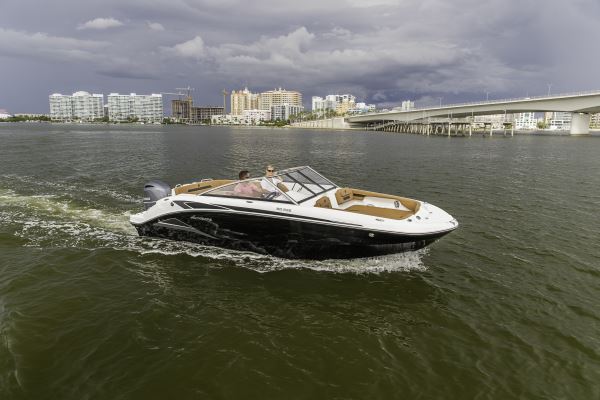 Before You Launch
Before You Launch
- Inspect all around the hose clamps for rust and replace as necessary. Double clamp fuel lines and exhaust hoses with marine-rated stainless steel hose clamps. While not technically required, it’s wise to double clamp whenever possible on all hoses — especially those below the waterline.
- Inspect all hoses for stiffness, rot, leaks and cracking, and replace any that are faulty. Make sure they fit snugly.
- Inspect prop(s) for dings, pitting and distortion. Make sure cotter pins are secure.
- Grip the prop (on inboard drive systems) and try moving the shaft up and down and side to side. If it’s loose and can be wiggled, the cutless bearing may need to be replaced.
- Check the rudderstock to ensure it hasn’t been bent. Operate the wheel or tiller to ensure the steering works correctly. Check the rudder bearing and steering cable for unusual play or movement.
- Inspect the hull for blisters, distortions and stress cracks.
- Make sure your engine intake sea strainer (if equipped) is not cracked or bent from ice and is free of corrosion, clean and properly secured.
- With inboards, check the engine shaft and rudder stuffing boxes for correct adjustment. A stuffing box should leak no more than two or three drops each minute when the prop shaft is turning. Check the shaft log hose for deterioration and rusty hose clamps.
- Inspect, lubricate and exercise thru-hull valves. It’s a good idea to tie a right-sized wooden bung to the valve in case of failure.
- Use a garden hose to check for deck leaks at ports and hatches. Renew caulk or gaskets as necessary.
- Inspect and test the bilge pump and float switch to ensure they’re both working properly. Also inspect the pump’s hose.
- Check stove and remote LPG tanks for loose fittings, leaking hoses and properly functioning shutoff systems. Use the pressure gauge to conduct a leak down test to check for system leaks.
- Inspect dock and anchor lines for chafe and wear.
- If equipped, ensure that the stern drain plug is installed.
- After the boat is launched, be sure to check all thru-hulls for leaks.
.jpg_600.jpg) Engines and Fuel Systems
Engines and Fuel Systems
- Inspect fuel lines, including fuel tank fill and vent hoses, for softness, brittleness or cracking. Check all joints for leaks, and make sure all lines are well supported with noncombustible clips or straps with smooth edges.
- Inspect fuel tanks, fuel pumps and filters for leaks. Ensure portable tanks and lines are completely drained of stale fuel before filling with fresh fuel. Clean or replace fuel filters and/or fuel-water separators if not done before winterization.
- Every few years, remove and inspect exhaust manifolds and risers for corrosion (for inboard-powered and inboard/outboard boats).
- Charge battery.
- Clean and tighten electrical connections, especially both ends of battery cables. Use a wire brush to clean battery terminals, and top off cells with distilled water (if applicable).
- Inspect the bilge ventilation intake and blower ducting for damage or leaks and run the blower to confirm correct operation.
- Test engine warnings and alarms.
.jpg_600.jpg) Engine Outdrives and Outboards
Engine Outdrives and Outboards
- Inspect rubber outdrive bellows for cracked, dried and/or deteriorated spots (look especially in the folds) and replace if suspect.
- Check power steering and power trim oil levels.
- Replace anodes/zincs that are more than half wasted.
- Inspect the outer jacket of control cables. Cracks or swelling indicate corrosion and mean that the cable must be replaced.
- Inspect lower unit oil level and top off as necessary.
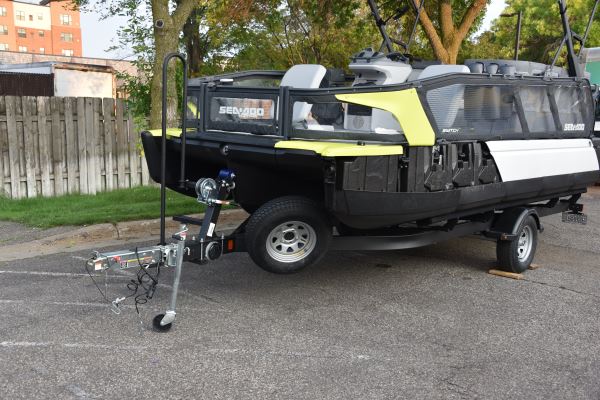 Trailers
Trailers
- Inspect tire treads and sidewalls for cracks or lack of tread and replace as necessary. Check air pressure; don’t forget the spare.
- Inspect wheel bearings and repack as necessary.
- Test all lights and replace any broken bulbs or lenses.
- Inspect winch to make sure it’s working properly. Inspect hitch chains.
- Inspect trailer frame and axel(s) for rust. Sand and paint to prevent further deterioration.
- Inspect brakes and brake fluid reservoir.
Safety
- A new law that went into effect in 2021 requires a vessel operator to use either a helm or outboard lanyard or wireless engine cutoff switch on certain vessels less than 26 feet when traveling on plane or above displacement speed, so be sure your switch is working properly and the lanyard is in serviceable condition. If you use a wireless cutoff switch, ensure batteries in the fobs and wrist worn devices are refreshed.
- Flares expire after 42 months so check expiration dates.
- Inspect fire extinguishers. A new regulation that goes into effect April 20, 2022, requires a 12-year expiration for disposables and has different carriage requirements for older and newer model year vessels.
- Ensure you have properly sized and wearable life jackets in good condition for each passenger, including kids. Check inflatable life jacket cylinders and dissolvable “pill” bobbins in auto-inflating models.
- Test smoke, carbon monoxide, fume and bilge alarms.
- Check running lights for operation and spare bulb inventory.
- Update chartplotter software.
- Replenish first-aid kit items that may have been used last season or are expired.
- Check the operation of VHF radio(s) and that the MMSI number is correctly programmed in. (BoatUS members can obtain a free MMSI number at BoatUS.com/MMSI.)
- Get a free vessel safety check from the U.S. Coast Guard Auxiliary or U.S. Power Squadrons. Find out more at cgaux.org/vsc
For the Dock
- In addition to checking its entire length for wear or abrasions, check both ends of the shore power cable connections as well as the shore power receptacle on the boat for burns, which indicate the cable and/or boat’s shore power inlet or the dock’s receptacle must be replaced.
- Test ground-fault protection on your boat and private dock, and know how to prevent Electric Shock Drowning.
The Paperwork
- Make sure your boat registration is up to date – and dinghy if you have one. Don’t forget your boat trailer tags
- Review your boat insurance policy and update coverage if needed. BoatUS provides free quotes at BoatUS.com/Insurance. Provide a copy to your marina or club.
- Ensure your BoatUS membership is in good standing, and check your TowBoatUS coverage by logging into BoatUS.com/Account, or join at BoatUS.com/Membership.
- Download the free BoatUS App (BoatUS.com/App to make it easy to summon on-water assistance and speed response times as well to check tide tables, weather, and partner discounts.
For more tips from BoatUS, visit boatus.com.
- Mindy Goodman
- Tags: boating pontoon boat spring




